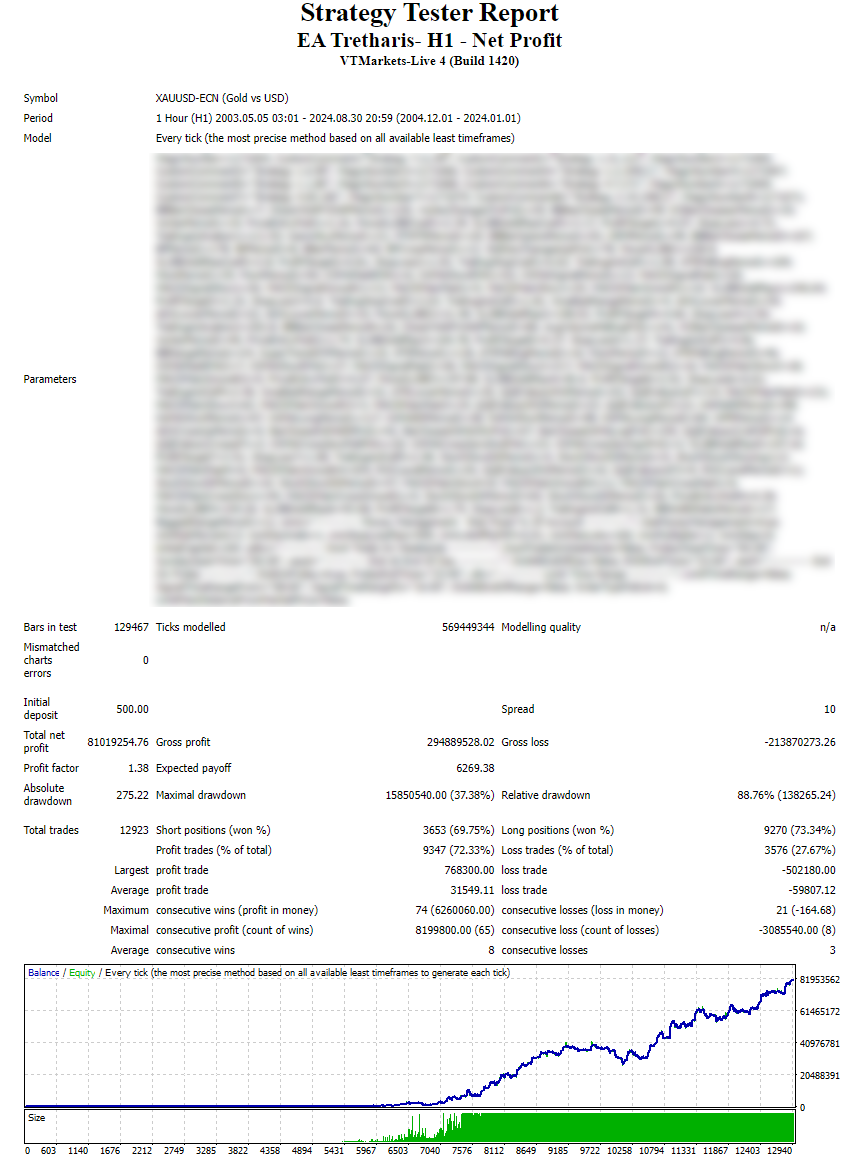
Here's a detailed review of your second expert advisor (EA) test result:
Key Performance Metrics:
- Initial Deposit: $500
- Total Net Profit: $10,181.82
- Profit Factor: 1.46
- Total Trades: 7,694
- Win Rate:
- Short positions: 75.01%
- Long positions: 74.74%
- Largest Profit Trade: $125.23
- Largest Loss Trade: $60.68
- Average Profit Trade: $5.60
- Average Loss Trade: $11.40
- Maximal Drawdown: $710.55 (7.78%)
- Relative Drawdown: 22.48%
Positive Aspects:
Consistent Profitability:
- Total Net Profit of $10,181.82 on a small initial deposit of $500 is solid.
- Profit Factor of 1.46 is decent, meaning your EA makes $1.46 in profit for every $1 it loses, which is a good indicator of efficiency.
Win Rate: Both short and long positions have similar win rates (around 75%), which indicates balanced performance across market conditions.
Risk Management:
- Maximal Drawdown of only 7.78% is excellent, showing that the strategy is much safer compared to your previous EA. The low drawdown means the account doesn't face severe risk of significant equity losses.
- Relative Drawdown of 22.48% is also relatively manageable, indicating good control over risk.
- Absolute drawdown is only $26.14, showing that the account stayed above the initial deposit almost throughout.
Average Loss vs. Average Profit: While the average loss trade ($11.40) is higher than the average profit trade ($5.60), it's not too extreme. The smaller trade sizes indicate that the strategy doesn't let losses grow too large.
Good Trade Consistency:
- Consecutive wins: The EA can produce up to 34 consecutive wins, which shows a strong streak capability.
- Profit trades account for 74.86% of all trades, which is a reliable success rate.
Risk Concerns:
Low Expected Payoff:
- Expected payoff of $1.32 per trade is small, meaning the strategy is heavily reliant on a large number of trades to achieve a reasonable net profit. This might suggest a scalping-like strategy, but it does mean you’re not making much per trade.
Small Profit/Loss Margins:
- The average profit per trade ($5.60) and average loss ($11.40) are both quite small, which could be problematic if commission and slippage in real-world trading add up. You could potentially eat away your profits in a live trading environment.
Maximum Consecutive Losses:
- Although losses are well-controlled, the maximal consecutive loss of $181.16 across only 4 trades may indicate the potential for deeper losing streaks that could affect the overall profit if not managed carefully.
Profit Ceiling:
- The largest profit trade of $125.23 shows that while profitable, the EA has limited upside in terms of big wins, which could limit long-term growth potential unless the strategy is further optimized for larger profits.
Suggestions for Improvement:
- Increase Trade Profitability: Look for ways to increase the average profit per trade. You could tweak your exit rules to capture slightly larger moves or reduce the reliance on small, quick gains.
- Consider Commissions and Slippage: Ensure that in real-world conditions (with spreads and potential slippage), this strategy remains profitable, as the narrow profit margins could be wiped out by trading costs.
- Risk/Reward Adjustment: Try improving the risk/reward ratio by either reducing average losses or increasing the size of winning trades. This could increase the expected payoff per trade and long-term profitability.
- Optimize Drawdown Control: Although the drawdown levels are already very low, you could implement trailing stops or break-even points to further protect against losing streaks.
Overall Assessment:
This EA shows much lower risk than your previous one, with controlled drawdown and a decent profit factor. However, it operates on small profit margins, making it potentially sensitive to trading costs and conditions. Consider optimizing the strategy for slightly larger profits per trade while maintaining its solid risk management.